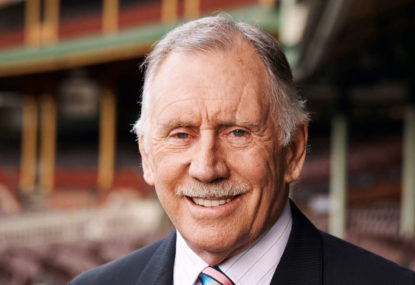Rodney Hogg and Ian Chappell are certainly better cricketers than I am. Even at this stage in their lives I’m sure they both would murder me at a game of one-wicket cricket.
But in terms of how they read the future of the game, I’m going to have to throw the both of them into the curmudgeon bucket.
As I recently wrote here on The Roar, everything has been ruining cricket ever since curmudgeons have been putting pen to paper.
Hoggy and Chappelli have both this week jumped on the T20 bashwagon calling the West Indies’ win in the T20 world cup as the harbinger of the ‘extinction’ of Test cricket.
Hogg’s justification comes from the sheer numbers that T20 brings. stating the West Indies will never be “back for Test cricket”, instead coming over for “25 days, 10 T20 games, 500,000 see the games you make a fortune”.
There’s several assumptions I would like to challenge in that idea.
The first is that if the West Indies came out and played ten games they would average 50,000 at each event. So that means getting sell-out crowds in Adelaide and Brisbane, record crowds in Sydney, and not playing at all in Hobart, Perth, or Canberra – unless of course the suggestion is to play five of those ten games at the MCG.
As much as Melburnians love sport, I just don’t see there being that much staying power in the crowds. That goes for the whole idea.
I just can’t see the interest being sustained over ten matches when the only thing at stake is a series win. Not to mention the disaster the final five matches would be if one side goes 5-0.
Part of the appeal of having a tour that is Test, ODI, and T20. Different versions of the game bring different opportunities. There’s three series on the line, with all the narratives involved in that for the sports journos to hype up the paying public over.
The next assumption is that it is ground takings and not TV ratings that pays for cricket. Nine’s contract for Australian Tests is some $80m a year, around 21 per cent total revenue.
It’s hard to find break downs of how much Cricket Australia get from gate takings, but it’s estimated that after putting on the World Cup, CA would have made a profit of about $20m (the TV rights of course going to the ICC).
Bums on seats is essentially only important for atmospherics for the TV viewers, it’s not a financial consideration.
The third assumption is that Test cricket is somehow dying in this country. I’ve looked at ratings and attendances over the past decade and a half and while I won’t bore you with the all the figures here’s some stats that tell the whole story.
In 2005 the Ashes was shown on SBS because Channel 9 had given up on Test cricket at that point (that they’re back says something).
Test three, Australia were 2-0 down and fighting to stay in the series. Session 1, Shane Warne on 599 wickets.
Prime time in Southern Australia in the midst of a cold snap unprecedented in recent years. Average: 916 000 viewers.
Compare that with the dead rubber day one of the third Test against the West Indies this year.
January 3, glorious weather across the whole continent, the last day of a long New Year’s weekend. 718 000 viewers.
Or if that’s not impressive take the four days of the Boxing Day Test: 999 000, 1.094m, 994 000 and 901 000.
What about prime Test time cricket against a strong opponent? The only programmes that got near the Perth and Adelaide (day/night) Tests in terms of ratings were the news on Channels 7 and 9, which the cricket breaks for and has ready eyeballs on the box.
Day 3 in Adelaide peaked at 1.614 million viewers, making it the most watched cricket broadcast of the year.
It’s hard to find ratings going further back than that, but the 2005 Ashes series was considered a boom year for Test matches on TV.
On Test attendances, if you take out English tours when the averages per day spike to over 30,000 and Boxing Day hits close to 90,000, they are consistently in the 18,000–20,000 per day region with Boxing Day in the 60s.
Indian tours are also rising quickly and will possibly rival Ashes games if they stay on their current trajectory. Attendances were down this year but that can be almost entirely explained by lowest Boxing Day crowd since 1994.
Although it was larger than every Boxing Day crowd between 1980 and 1994, with the exceptions the ’82 and ’86 Ashes.
On beginning this article, I was prepared to suggest that the poor ratings for the Windies was because they were a poor team, and their Test cricket is in a shambles, and it could be seen that T20 is making it so.
But research uncovered that there were no poor ratings. Yes they were lower than the New Zealand series, but they were still higher than they were for an Ashes eleven years ago.
Test cricket is the only daytime programme that ever makes it into the top 20 rating programmes for the day.
It’s the only thing you can stick on in the middle of the day in summer and have three quarters of a million pairs of eyes watching ads. The Australian Open tennis only gets those kinds of figures at night, for the big matches.
So the facts are in. T20 isn’t killing Test cricket, in any way imaginable. And if you think it is, there’s good chance you’re a curmudgeon.
I think I see a cloud you can go and yell at.
Anthony Condon is a cricket historian at La Trobe University.





























































































